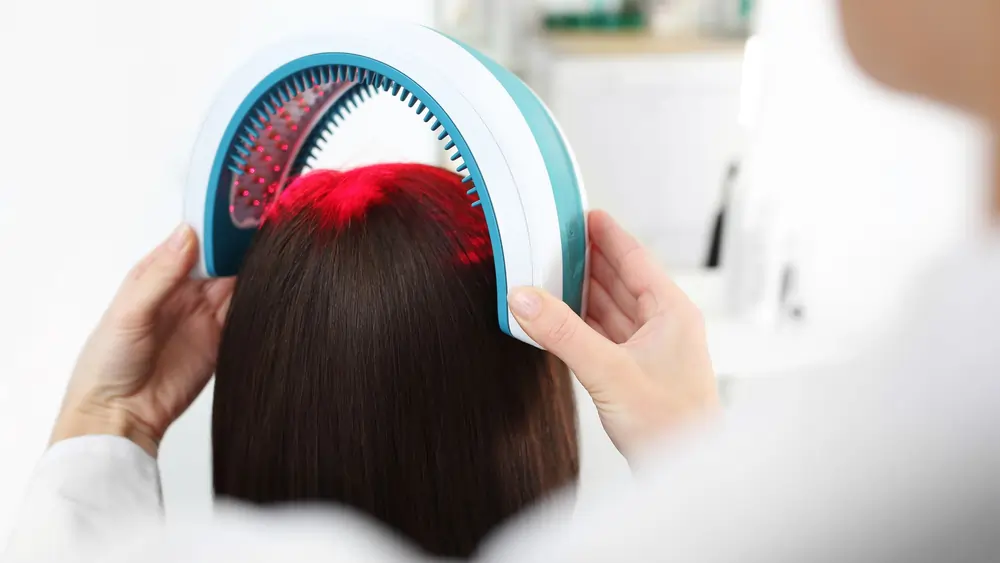As winter blankets the world in a frosty embrace, many individuals find themselves grappling with an unexpected concern — winter hair loss. It’s a phenomenon that sparks worry and confusion, with questions abound. Does the winter weather truly have an impact on our locks, or is this just another seasonal myth? In this article, we embark on a journey to unravel the intricacies of winter hair loss, delving into the science behind the strands and exploring the factors that contribute to this seasonal challenge.
Hair, a dynamic and ever-changing feature of our bodies, undergoes natural cycles of growth, rest, and shedding. However, as the temperatures drop and the air becomes drier, the winter months can present unique challenges to the health of our hair and scalp. From the chilling winds outdoors to the warmth of indoor heating, our tresses face a barrage of environmental influences that can influence their vitality.
Throughout this exploration, we aim to demystify the causes of winter hair loss, distinguish fact from fiction, and empower you with practical insights to navigate this seasonal concern. Whether you’re experiencing heightened hair shedding or simply seeking ways to fortify your locks during the colder months, join us in understanding the nuances of winter hair loss and discovering effective strategies to maintain a vibrant and healthy hair. (If you’re living in a part of the world where it is currently summer, don’t miss our informative article with summer hair care tips!)
Understanding Winter Hair Loss: A Dive into the Hair Growth Cycle
To comprehend the intricacies of winter hair loss, it’s essential to first grasp the fundamentals of the hair growth cycle. Our hair undergoes a continuous process of growth, rest, and shedding, known as the anagen, telogen, and catagen phases, respectively. The anagen phase is the active growth phase, where hair follicles generate new cells, and hair visibly extends. Following this, the catagen phase is a transitional stage, and finally, the telogen phase marks a period of rest before shedding.
The natural shedding of hair is a normal part of this cycle, with individuals typically losing around 50 to 100 hairs per day. However, environmental factors, particularly those associated with winter, can disrupt this delicate equilibrium.
The Impact of Seasonal Changes: Cold, Dry Air, and Indoor Heating
As winter descends, so do the temperatures, and with them come a set of challenges for our hair. Cold air has the potential to constrict blood vessels, limiting the flow of essential nutrients to the hair follicles. This reduction in blood circulation can impact the anagen phase, leading to a higher percentage of hairs entering the telogen (resting) phase simultaneously. The result? An apparent increase in hair shedding during the winter months.
Moreover, the dry air characteristic of winter, both outdoors and indoors, can wreak havoc on the moisture balance of the scalp and hair. Dryness may cause the hair shaft to become brittle and more prone to breakage, exacerbating the appearance of hair loss.
Indoor heating systems, while providing warmth, contribute to the overall aridity. As they sap moisture from the air, they also dehydrate the hair, leaving it more susceptible to damage. This trifecta of cold temperatures, dry air, and indoor heating sets the stage for winter hair loss, disrupting the natural harmony of the hair growth cycle.
5 Common Causes of Winter Hair Loss: Unraveling the Tangle
As winter’s chill sets in, a variety of factors can contribute to the disconcerting experience of increased hair shedding. It’s crucial to identify and understand these common causes to address winter hair loss effectively.
- Reduced Blood Circulation: Cold weather constricts blood vessels, limiting the flow of oxygen and nutrients to hair follicles. This constriction can disrupt the normal hair growth cycle, pushing more hairs into the resting phase and subsequently increasing shedding. Improving blood circulation to the scalp becomes pivotal in maintaining a healthy hair growth environment during winter.
- Vitamin Deficiencies: Winter often brings a shift in dietary habits, with fewer fresh fruits and vegetables readily available. This can lead to deficiencies in essential vitamins and minerals crucial for hair health, such as vitamin D, iron, and zinc. These nutritional gaps may impact the strength and resilience of hair, contributing to increased shedding.
- Hormonal Changes: Fluctuations in hormone levels, which can be influenced by seasonal changes, stress, or lifestyle adjustments, may play a role in winter hair loss. Hormones like cortisol, often elevated during stressful periods, can affect the hair growth cycle. Understanding and managing stress becomes integral to mitigating its impact on hair health.
- Dry Scalp and Hair Shaft: The winter air, notorious for its lack of humidity, can lead to dry and flaky scalps. This dryness extends to the hair shaft, making it more prone to breakage and contributing to the perception of increased hair loss. Hydrating the scalp and hair becomes paramount in preventing winter-induced damage.
- Stress: Winter can bring its own set of stressors, from holiday pressures to weather-related challenges. Stress, whether acute or chronic, can trigger or exacerbate hair loss. Managing stress through relaxation techniques, exercise, and self-care practices is essential for overall well-being and hair health.
By acknowledging these common causes, we lay the foundation for proactive measures to counteract winter hair loss. In the subsequent sections, we will dispel prevalent myths surrounding this seasonal concern and explore practical strategies for prevention and care, empowering individuals to embrace the winter months with confidence in the resilience of their hair.
Debunking Myths: Separating Fact from Fiction in Winter Hair Loss
Winter hair loss often comes with a flurry of myths and misconceptions, adding to the anxiety that many individuals feel during the colder months. It’s time to dispel these myths and provide clarity on what’s truly happening with our hair when the temperature drops.
1. Myth: Winter Causes Permanent Hair Loss
- Fact: The majority of winter hair loss is temporary and part of the natural shedding process. Hair shedding tends to increase during certain seasons, but this is typically a temporary phase. Permanent hair loss is more often linked to genetic factors, hormonal imbalances, or underlying health conditions.
2. Myth: Hats Cause Hair Loss
- Fact: Wearing hats in winter doesn’t cause hair loss. While it’s true that tight hairstyles or hats that pull on the hair can contribute to breakage, the act of wearing a hat alone doesn’t lead to permanent hair loss. In fact, hats can protect the hair from harsh weather conditions, reducing the risk of damage.
3. Myth: Indoor Heating Directly Causes Hair Loss
- Fact: While indoor heating systems can contribute to dryness, they don’t directly cause hair loss. The key is to maintain a balance—moisturize the air in your living spaces and keep your hair well-hydrated. Using a humidifier and adopting a proper hair care routine can help counteract the drying effects of indoor heating.
4. Myth: Winter Hair Loss is Unavoidable
- Fact: While seasonal shedding is normal, there are proactive measures you can take to minimize its impact. Understanding the causes of winter hair loss and adopting a targeted hair care routine can significantly reduce shedding and promote overall hair health.
5. Myth: Only Men Experience Winter Hair Loss
- Fact: Both men and women can experience increased hair shedding during the winter months. While certain types of hair loss may be more common in men, seasonal shedding is a concern for individuals of all genders.
Preventive Measures: Nurturing Your Hair Through Winter
As we navigate the complexities of winter hair loss, it’s essential to arm ourselves with preventive measures to maintain the health and vitality of our hair. By adopting proactive strategies, individuals can minimize the impact of seasonal factors on hair shedding and promote an environment conducive to robust hair growth.
Scalp Massage and Improved Blood Circulation: Regular scalp massages stimulate blood flow to the hair follicles, promoting nutrient delivery and a healthy growth environment. Consider incorporating gentle massage techniques into your hair care routine to counteract the effects of reduced blood circulation during winter.
Balanced Nutrition and Supplements: Ensure a well-rounded diet rich in vitamins and minerals essential for hair health. Consider supplements under the guidance of a healthcare professional, especially if winter dietary changes lead to nutritional gaps. Vitamin D, iron, and omega-3 fatty acids are particularly beneficial for hair strength.
Hydration for Hair and Scalp: Combat the dryness of winter air by keeping your hair and scalp well-hydrated. Use a moisturizing shampoo and conditioner, and consider incorporating a hydrating hair mask into your routine. For the scalp, a nourishing oil treatment can provide essential moisture.
Stress Management: Practice stress-reducing activities such as meditation, yoga, or deep breathing exercises. Managing stress not only contributes to overall well-being but also plays a crucial role in preventing stress-induced hair loss.
Protective Hairstyles and Headgear: Opt for loose hairstyles that minimize tension on the hair shaft, reducing the risk of breakage. When braving the winter elements, wear a hat or headgear to shield your hair from the cold wind and harsh weather conditions.
Hair Transplant as an Option for Permanent Hair Loss: For individuals facing persistent and irreversible hair loss, hair transplant surgery emerges as a viable option. This procedure involves the transplantation of hair follicles from donor areas to areas with thinning or no hair. Contact our experts to find out if you’re a candidate for a hair transplant in Turkey.
As we embrace these preventive measures, it’s important to recognize that individual experiences with winter hair loss vary. While some may find success in lifestyle adjustments and targeted hair care, others may explore more advanced interventions such as hair transplant surgery.
Final Thoughts: the Perfect Hair Care Routine for Winter
Winter ans the seasonality of hair shedding demands a specialized approach to hair care, considering the unique challenges posed by cold temperatures, dry air, and indoor heating. By tailoring your routine to address these factors, you can fortify your strands and minimize the impact of winter on your hair. Here’s a comprehensive guide to nurturing your locks through the colder months:
- Moisturizing Shampoo and Conditioner:
- Switch to a moisturizing shampoo and conditioner to combat the dryness caused by winter air. Look for products with ingredients like argan oil, shea butter, or glycerin to help retain moisture and enhance the resilience of your hair.
- Hydrating Hair Masks:
- Treat your hair to a hydrating mask once a week. This extra boost of moisture can revitalize dry and damaged strands, providing the nourishment they need to withstand the winter elements.
- Limit Heat Styling:
- Minimize the use of heated styling tools, as these can contribute to further dryness and damage. If styling is necessary, use a heat protectant spray to shield your hair from the potential harm caused by heat.
- Regular Trims:
- Schedule regular trims to prevent split ends and breakage. Trimming away damaged ends promotes healthier growth and helps maintain the overall integrity of your hair.
- Scalp Care:
- Pay attention to your scalp health by incorporating a gentle exfoliating scalp scrub into your routine. This helps remove any dry, flaky skin and encourages a healthier environment for hair growth.
- Protective Hairstyles:
- Opt for protective hairstyles that keep your hair secure and minimize exposure to the harsh winter elements. Braids, twists, and buns can be stylish choices that also protect your strands from environmental stressors.
- Humidifier Usage:
- Introduce a humidifier into your living spaces to counteract the dryness caused by indoor heating. This not only benefits your skin but also helps maintain the moisture balance of your hair.
- Overnight Treatments:
- Treat your hair to overnight conditioning treatments. Apply a nourishing oil, such as coconut or jojoba oil, to the ends of your hair before bedtime. This allows the oil to penetrate deeply, providing intense hydration.
By incorporating these tips into your winter hair care routine, you create a shield against the adverse effects of the season, ensuring that your hair remains healthy, vibrant, and resilient.




